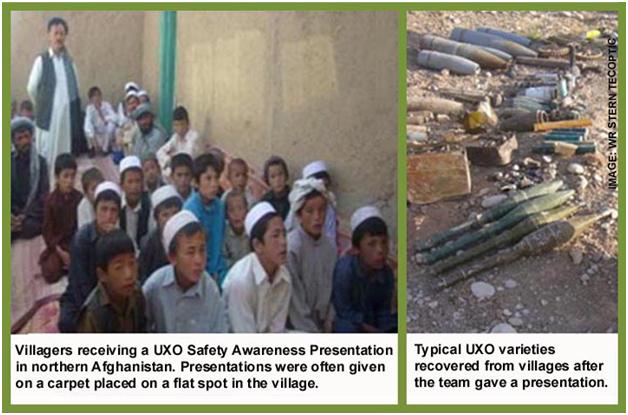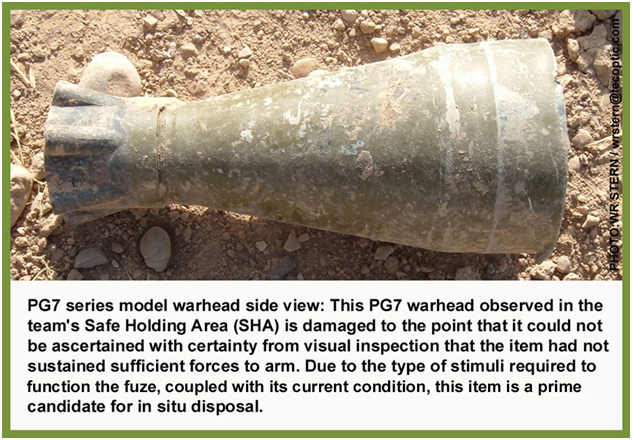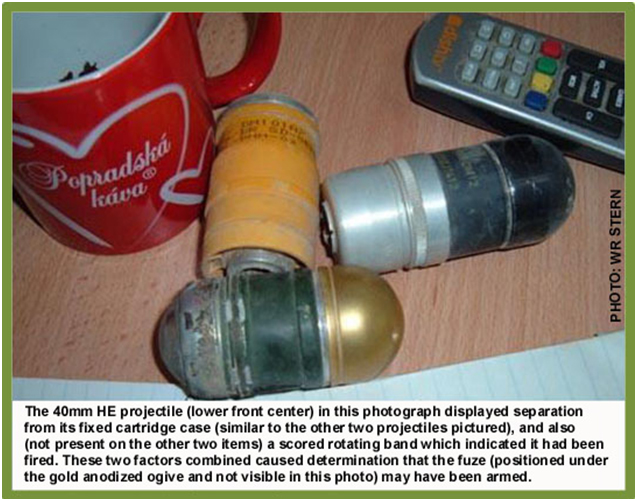Vigilance Pays Off For EX-PAT UXO Contractors
Article by Ward R Stern.
When working in a foreign and potentially hostile environment, the EX-PAT EOD/UXO contractor should always remain vigilant of the peripheral dangers, not the least of which is the potential from an insider threat. Whether it is an intentional act on the part of a nefarious character that has slipped through the vetting process or hazards manifesting due to the improper actions of a local hire employee; the informed EX-PAT EOD/UXO contractor technician becomes aware and is therefore better able to establish an effective protective posture plan against the potential of hazards which can approach and attempt to penetrate their protective security sphere from any direction or location.
An example of a real world situation in which vigilance paid off for me and the safety of others occurred back in 2010 when I was assigned as a Technical Advisor to an Afghanistan citizen comprised UXO team trained to International Mines Action Standards (IMAS). The team to operated in Samangan Province, Afghanistan and consisted of thirteen IMAS (Levels 1-3) technicians led by an Afghan Team Leader (IMAS Level 3). My direction (instructions received while in Kabul) was to mentor this team so that they could operate in a safe, efficient and effective manner. One facet of the assignment involved advising the team on best practices involving UXO safety, identification and disposal operations.
A primary focus of the team, observed on my arrival in Aibak, Samangan in early September 2010, was for them to travel out to villages in our area of operations and present UXO identification and safety awareness presentations to villagers. The team would liaison with a village elder or Malik (a village religious figure) prior, and set up a date, time and place (most times just a flat spot in the village where a carpet was placed) to conduct a presentation.

After a presentation had been made, the team leader would inquire if anyone in attendance had knowledge of the whereabouts of any UXO in proximity to the village. This inquiry would at times illicit a positive response from a village member that they had knowledge of the whereabouts of an ordnance item. The team would then, in theory, either dispose of the item or items in situ (i.e. blow in place [BIP]) or (if safe to transport) relocate and secure the item at a designated disposal range for disposal by detonation.
This Explosive Ordnance Recognition (EOR) presentation coupled with the removal/ elimination of explosive hazard approach was right up my alley. The technique was simple, effective and exactly what I have trained and practiced my entire adult life. The country of Afghanistan is where lay some of south Asia's most extreme landmine and UXO contaminated areas. In Afghanistan there is a battle being waged against injuries sustained by citizens from the explosive remnants of war. I was quite enthused about the program and the opportunity to participate in this UXO public safety campaign for the populace of Afghanistan.
One of my first actions on settling into the position was to check the team's ordnance holding area. On inspection I observed that they had accumulated quite a collection of UXO items from their excursions into the hinterland that I would rather have had them dispose of in situ rather than having transported back to the range for disposal. I coordinated with the team leader and selected a range day for all of us to clear out the holding area and do a disposal of accumulated items for various safety and security reasons. This disposal operation would also afford me a prime opportunity to observe the team's explosives handling and demolition procedures. Observing their performance during this disposal operation would enable establishment of a base line from where any technical assistance from me would have a foundation on which to build.
Witnessing their holding area compliment to be disposed of that day though, it became apparent that the team needed to conduct more disposal of UXO in situ. I stressed the point to the team leader that for safety reasons they needed to destroy UXO in situ when required and whenever possible. Through our conversation it surfaced as obvious that; their previous training, continued repetition of bad habits, or his lack of desire to admit to having committed an error maintained submunitions were to be destroyed in situ, but his explanation ended there. His communicated knowledge to me fell off after that as far as how an ordnance item's condition (damaged vs. undamaged or fired vs. unfired) could influence fuze condition determination (armed vs. unarmed) thus being a variable in selection of disposal method, either BIP or transport to a demolition area for disposal at a later date. Omitting those key (and understandably extremely basic) determining factors; it appeared that they transported all items (minus submunitions) recovered to the demo area for "Demo Thursday". For me this showed a serious flaw in the team's operational procedures that needed to be addressed further and immediately rectified in order to prevent injury or fatalities due to an unintentional detonation from improper handling, transport and disposal of dangerous UXO.

This particular deficiency was hammered home when shortly after our discussion on the demolition range; the team leader carried a sandbag containing various nomenclatures of 40mm projectiles into the Safe House Area (i.e., living quarters). I stopped him after I realized what was in the bag and what he intended to do with the contents. His intent was to lay each one of the projectiles out on my desk like a display. He wanted to show me what the team had recovered during that day's evolution and request identification of the items from me. Of particular and immediate interest was a 40mm high explosive (HE) projectile separated from its cartridge case and possessing a potential of being armed. The gold anodized ogive was in pristine condition with no dings or mars visible on the thin aluminum cover, but score marks imparted on the rotating band of the round that were caused on firing by the lands and grooves in a weapon's barrel were present.

This situation provided an opportune catalyst by which I could impact this team leader with a significant emotional event. After clearing the house of occupants, removing the UXO items from the structure through completion of a series of labor intensive tasks (involving boxes filled with sand) carried out by the team, counseling the team leader in writing concerning bringing UXO into the structure (how another incident of this type would provide upward mobility potential for the assistant team leader) and discussing identification features of fixed, semi-fixed and separate loading ammunition with the aid of dry erase markers and a white board (and how these key features could be used to determine if a specific piece of projected ordnance was in fact fired and therefore potentially armed), I decided the time was ripe for immediate controls to be emplaced. I made the entire event as uncomfortable as possible for him in the hope that after the experience, the next time a question arose in his mind concerning a piece of ordnance that he would call me to come to the site rather than inappropriately carrying it from the site where it had been found and having to potentially endure that spectacle again. Effective communication between the team leader and me (I believe) had been attained in this instance, without the necessity of involving the translator.









